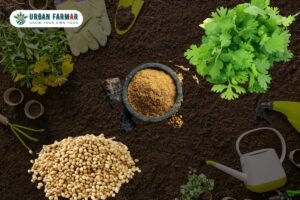Growing your own vegetables is a rewarding experience, and Bottle Gourd (Lauki) is a fantastic choice for home gardening. Known for its versatility in Indian cuisine, Bottle Gourd can be grown easily on terraces and balconies, providing you with fresh, organic produce all year round.
Introduction to Bottle Gourd (Lauki)
Bottle Gourd, scientifically known as Lagenaria siceraria, is a vine crop that thrives in warm climates. This nutritious vegetable is rich in vitamins, minerals, and antioxidants. Lauki is used in various dishes, from curries to juices, making it a staple in many households. Growing it at home ensures chemical-free, fresh produce that tastes amazing.
Varieties of Bottle Gourd You Can Grow
- Pusa Naveen (Hybrid) – Smooth, cylindrical, and fast-growing.
- Arka Bahar (Hybrid) – High-yielding and resistant to common diseases.
- Round Bottle Gourd – Ideal for curries and stuffed dishes.
- Long Bottle Gourd – Perfect for juices and curries.
Why Grow Bottle Gourd at Home?
- Fresh and Organic Produce: Ghar ka ugaya Lauki ensures chemical-free, healthy vegetables.
- Cost-Effective: Reduces dependency on market-bought vegetables.
- Therapeutic Hobby: Gardening is a relaxing and fulfilling activity, helping reduce stress.
- Sustainable Living: Reduces your carbon footprint by growing food at home.
Step 1: Preparing for Planting
Choosing the Right Container
- Use large containers or HDPE grow bags (minimum 18-24 inches deep).
- Ensure the container has drainage holes to prevent waterlogging.
- A trellis or support structure is necessary for the vine to climb. Bottle Gourd vines are vigorous and require space to spread.
Preparing the Potting Mix
For healthy growth, use a nutrient-rich potting mix:
- 40% Garden Soil
- 30% Coco Peat or Compost
- 20% Vermicompost or Organic Manure
- 10% Sand or Perlite for aeration
- Add a handful of bone meal or neem cake for better root development.
Container Placement
- Place containers in a spot that receives 6-8 hours of direct sunlight daily.
- Ensure good air circulation to prevent fungal diseases.

Step 2: Sowing the Seeds
- Soak Bottle Gourd seeds in water overnight to boost germination.
- For faster germination, you can scarify the seed coat lightly.
- Sow seeds 1-2 inches deep in moist soil, maintaining a gap of at least 1-2 feet between plants.
- Cover lightly with soil and gently water.
- Keep the soil moist, not waterlogged.
Step 3: Germination and Early Care
Germination Timeline
- Seeds typically germinate within 7-14 days under warm conditions.
- If temperatures are low, germination may take longer.
- Keep the soil consistently moist but avoid waterlogging.
- Once seedlings are 4-6 inches tall, thin out weaker ones to promote strong growth.
Caring for Young Plants
- Move the container to a sunny spot.
- Use stakes or a trellis to guide the young plants to climb.
- Mulch around the base to retain moisture and reduce weeds.
- Check regularly for pests and diseases.
Step 4: Ongoing Care and Maintenance
Watering and Feeding
- Water deeply and regularly, especially during flowering and fruiting.
- Reduce watering during the rainy season.
- Apply organic fertilizer every 2-3 weeks. Use liquid compost or vermicompost tea for better growth.
- Add potassium-rich fertilizers during flowering to encourage more fruits.
Pruning and Support
- Train the vine along a trellis or support structure.
- Prune excess foliage to promote airflow and sunlight exposure.
- Remove any side shoots to direct energy to fruiting.
Step 5: Pest and Disease Management
Common Pests and Solutions
- Aphids, Whiteflies, and Spider Mites: Use neem oil spray every 7-10 days.
- Powdery Mildew: Ensure good airflow and avoid overwatering.
- Root Rot and Fungal Infections: Avoid waterlogging and use well-draining soil.
- Fruit Flies: Use yellow sticky traps and neem oil.
Natural Remedies for Pest Control
- Garlic and chili spray as an organic pesticide.
- Neem oil spray for common pests.
- Companion planting with marigold or basil to repel insects.
Step 6: Harvesting Bottle Gourd
- Bottle Gourds are ready for harvest in 60-80 days after sowing.
- Harvest when the gourd is tender and firm, about 10-12 inches long.
- Avoid letting the fruit mature too much, as it becomes hard and less tasty.
- Cut with a sharp knife or scissors, leaving a small stalk attached.
FAQs About Growing Bottle Gourd
Why are my Bottle Gourds turning yellow?
This can result from overwatering, nutrient deficiency, or pest infestation.
Can I grow Bottle Gourd indoors?
It needs full sunlight, so a terrace or balcony is ideal.
How often should I water my plant?
Keep the soil moist, especially during hot weather.
Why are my Bottle Gourds small?
Ensure the plant receives enough sunlight and nutrients.
How can I control pests naturally?
Use neem oil or a homemade garlic spray.
When should I prune my Bottle Gourd plant?
Prune excess growth regularly to promote better fruiting.
Conclusion
Growing Bottle Gourd at home is simple and rewarding. With patience and proper care, you can enjoy fresh, healthy Lauki straight from your terrace or balcony. Start your own Bottle Gourd garden today and experience the joy of homegrown produce. Happy Gardening!




